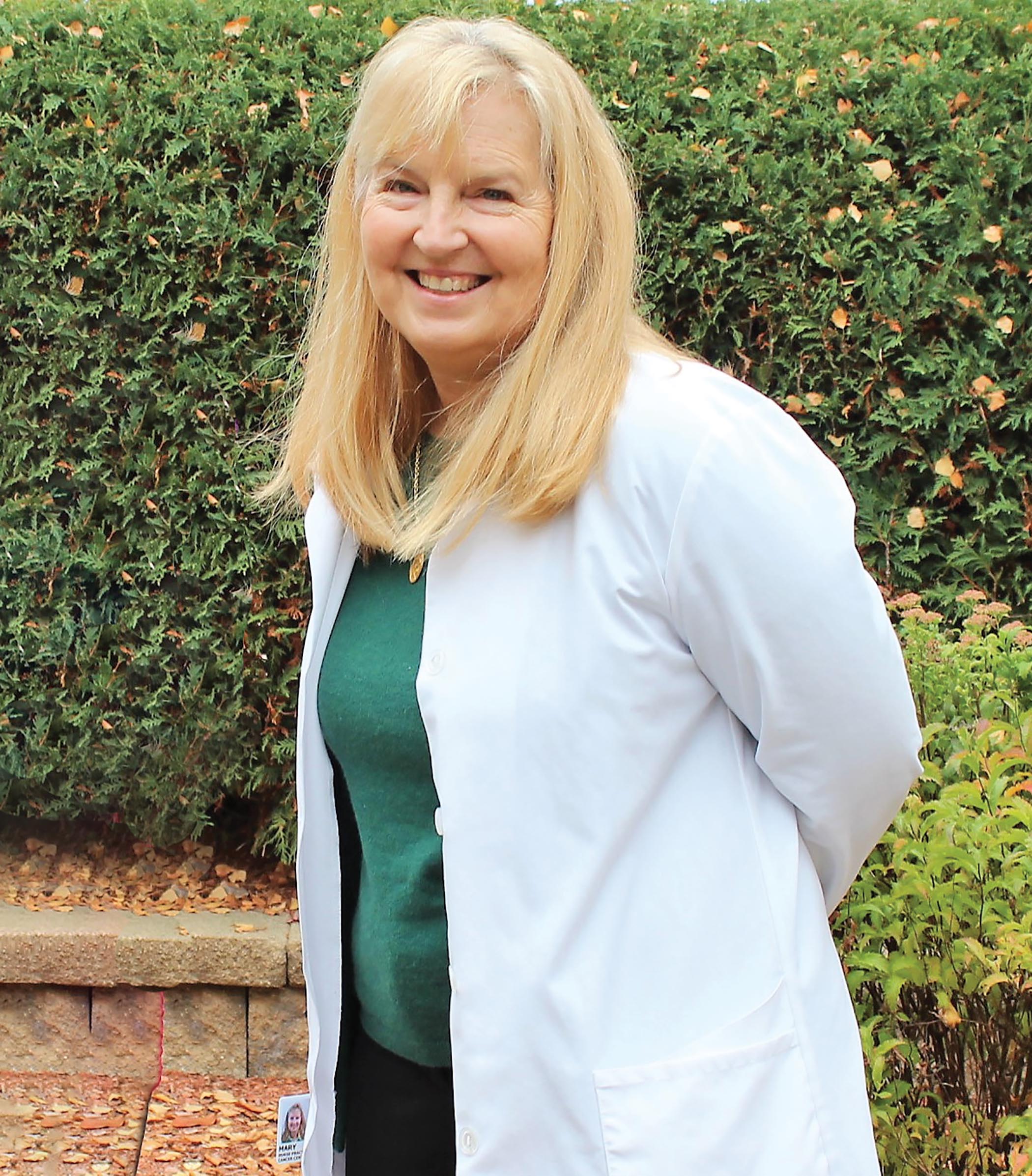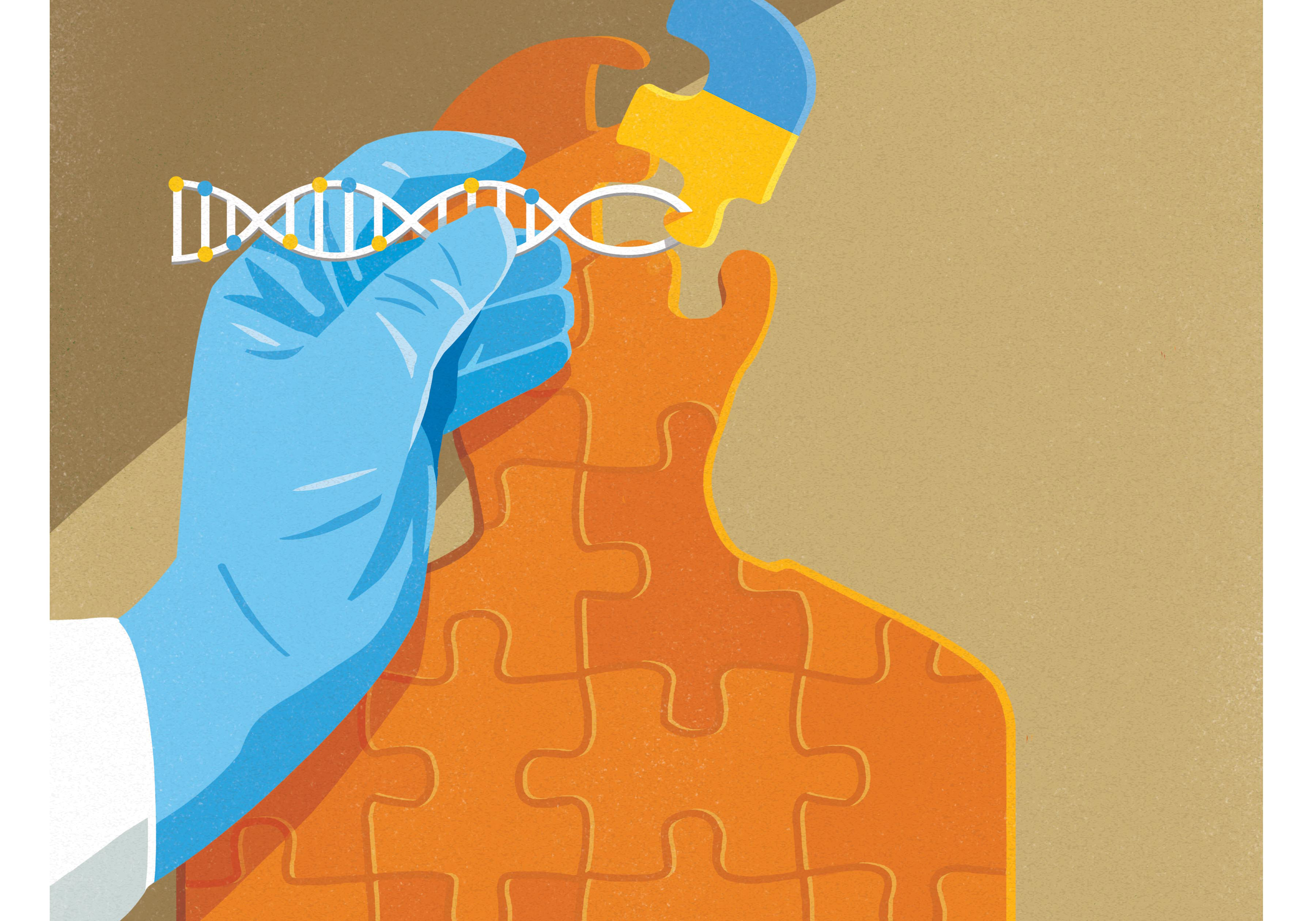Since the mapping of the human genome in 2003, genetic testing has rapidly evolved from single-gene tests to more complex profiles that measure multiple genes; it’s now part of standard care for many cancer types. Precision oncology allows clinicians to take patient-specific genomic factors into consideration when making treatment decisions, which can lead to improved outcomes, lower overall cost, and fewer side effects.

The Evolution of Genetic and Genomic Testing
“Genetic science has significantly changed the way we approach testing for and treating hereditary cancer syndromes,” ONS member Elisabeth King, AGN, AOCNP®, FNP, RN, executive director of genomics and precision medicine at City of Hope National Medical Center in Duarte, CA, and member of the Central Texas, Greater Los Angeles, and Inland Empire ONS chapters, said. “Clinicians use genetic testing information to either prevent cancer or catch cancers early—both in our patients and in their families.”
ONS member Mary Schmitt, MS, FNP-BC, APRN, AOCNP®, is one such clinician: she uses genetic testing as a nurse practitioner at St. Joseph’s Hospital’s high-risk breast cancer clinic in Nashua, NH.
“Identifying a family at high risk for cancer may lead to genetic testing for cancer susceptibility,” Schmitt, who is a member of the Southern New Hampshire ONS chapter, said. “If a harmful variant in a tumor suppressor gene such as BRCA1 or a DNA repair gene like MSH2 is identified in a patient, it may guide treatment decisions and additional screening for other cancers.”

Sometimes, Schmitt said, the information leads to cascade testing in the patient’s family members. A systematic process, it begins with identifying a condition or a pathogenic variant associated with the condition in an individual patient and then extends genetic testing to at-risk biologic relatives. The findings can help patients and clinicians decide together about whether to pursue more intense screening, risk-reduction surgery, or chemotherapy prevention.
“A patient may have mixed feelings about being the first in their family to identify a hereditary cancer, but it may be a great benefit—perhaps even lifesaving—for other members,” Schmitt said. “Genetic counseling serves an important role in preparing a patient for the psychological impacts this testing may have on the patient and other family members.”
“Comprehensive knowledge and skills related to cancer pathophysiology, treatment options, and symptom management are core aspects of oncology nursing, and all these factors are now heavily reliant on genomics,” King said. “Oncology nurses should understand the importance of accurate genomic testing in order to help guide the best possible treatment decisions for their patients.”
A Common Taxonomy Creates Consistency
“The study of genomics is new, and the taxonomy is evolving,” Schmitt said. “Last year the ONS Genomics Advisory Committee made a commitment to standardize terms used in cancer genomics.”
The standardized genomics taxonomy (ons.org/genomics-taxonomy) includes:
- Gene: basic unit of hereditary, in a specific location on a chromosome, containing nucleotides
- Variant: once called a mutation, any change to the DNA sequence compared to the reference genome or control
- Wild-type gene: a gene in its natural form, as it is found in nature
As for the difference between the overarching terms, genetics is the study of a single gene, its effect on health, and how it is passed to offspring, King and Schmitt said, whereas genomics refers to the study of the entire genome: all the genes an individual has and the interactions of many genes with each other and with the environment.
“With advancements in technology, the line between genomics and genetics has blurred,” King said. “From a pragmatic perspective, oncologists often use genomics to describe somatic or tumor testing, and they describe genetics as germline or hereditary testing.”
Variants also have different types and terminology. “Germline variants are changes that a person is born with that they inherited from their parents. Germline variants can be passed down to a person’s offspring,” King said. “Somatic variants have happened in a group of cells over time because of exposures or aging that have led to cancer. They have treatment implications but are not hereditary.”
How Biomarkers Guide Diagnosis and Treatment
“Biomarkers are molecules that are produced by normal or cancerous cells,” King said. “They may be used to determine disease diagnosis or prognosis and may aid in treatment decisions and disease monitoring.”
Biomarkers can be as basic as pulse and blood pressure or standard chemistry panels or more complex blood or tissue tests. Oncology biomarkers may be a molecule secreted by a tumor or a specific bodily response to cancer. Some may require a biopsy or advanced genomic testing to uncover, but many can be found in routine blood, urine, or stool tests.
“Biomarker testing is the cornerstone of the diagnosis and treatment of breast cancer,” Schmitt said. “We have long used biomarkers like estrogen receptors, progesterone receptors, and HER2 to identify subtypes that predict prognosis and treatment response.”
King said that neurotrophic tyrosine receptor kinase and microsatellite instability recently emerged as tumor-agnostic biomarkers that allow for precision cancer treatments.
“Knowledge of the genomic alterations that drive cancer growth and proliferation is as important as understanding the side effects of chemotherapy,” King said. “Soon most cancer treatment will be based on genomic biomarkers, either from tissue or liquid biopsy. As cancer progresses through treatment, we will be looking for new alterations to target with precision drugs.”
What About Direct-to-Consumer Testing?
Easy to purchase and use, at-home genetic testing kits are rising in popularity across the United States, but they often don’t provide any actionable insight for cancer.
“Patients and providers may overestimate what they will learn from direct-to-consumer testing and may be disappointed with the limited clinical significance of the results,” King said. If price is a barrier, “the cost of testing may not be covered by one patient’s insurance, but opportunities may exist for testing through clinical trial participation or by working with financial assistance programs.”
“Teaching patients about genetics and genomics is so necessary because of direct-to-consumer advertising for cancer treatment, which introduces some of the science behind targeted agents and immunotherapy,” Schmitt said. “This requires nurses to initiate open dialogue surrounding testing for gene alterations, both acquired and inherited.”
Schmitt said that she uses visual illustrations of cell receptors and how agents block growth messages into the cell as teaching aides with her patients. She also encourages patients to resources from reputable organizations like NCI, OncoLink, and My Cancer Genome.
“City of Hope’s Accountable Precision Oncology Program was created to connect experts in precision oncology with primary oncologists. This subspecialized expertise is often not available in a patient’s community,” King said. “It brings experts into the communities to make recommendations for genetic and genomic testing, provide accurate interpretation of test results, and give advice for optimal treatment.”
All Nurses Have a Role
Nurse navigators are crucial in facilitating timely access to genomic profiling, and their work doesn’t stop there.
“Nurse navigators need to use genomic testing results as the drivers of treatment pathways,” Schmitt said. “As tests and treatment indications become more tissue agnostic, treatment will be based on genomic profiles rather than tumor origin.”
And all nurses are involved in genomics and genetics, not just navigators, King and Schmitt said. Nurses are trusted patient advocates, helping to tailor individualized care and support patients through treatment.
“As key members of interprofessional teams, nurses assist patients in making informed decisions, navigating insurance authorizations, and engaging in clinical trial participation,” Schmitt said. “Nurses may be called to research actionable drugs or explore alternatives through the right to try law and other compassionate use programs.”
“We are only at the earliest stages of harnessing the power of genomics in the prevention and treatment of cancer,” King said. “Oncology nurses have a critical role in using genomics as a tool on the front line of cancer care.”
Schmitt said that she often conducts hereditary cancer risk assessments among her patients in a high-risk breast cancer clinic. “At breast cancer diagnosis, all men and many women are evaluated for referral for genetic counseling for hereditary cancer testing,” she said. “If genetic testing identifies a hereditary cancer, a patient may consider a different surgical plan and a change in adjuvant radiation planning.”
A nurse’s role in genomic risk assessment, Schmitt said, includes:
- Obtaining family histories
- Identifying red flags for hereditary cancers
- Encouraging and providing genetic counseling
- Educating patients about genomic testing
- Interpreting complex test results
“Each patient is unique, and when finding new and exciting ways to treat cancer, we must always assess quality of life, risks and benefits of treatment, and impact of loved ones in the shared decision-making process,” Schmitt said. “Precision oncology may not lead to cure, so we must always balance longer progression-free survival with a treatment’s effect on quality of life.”
“With precision medicine, genetic testing has become the principal method for determining targeted treatment options,” King said. “It is an exciting time to be an oncology nurse. We are only at the earliest stages of harnessing the power of genomics in the prevention and treatment of cancer.”






